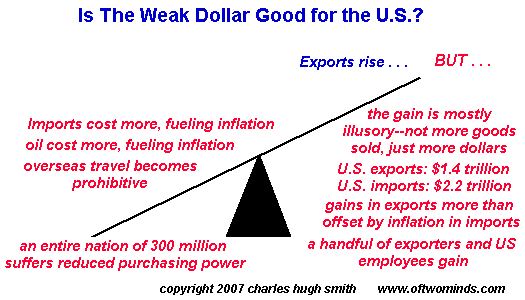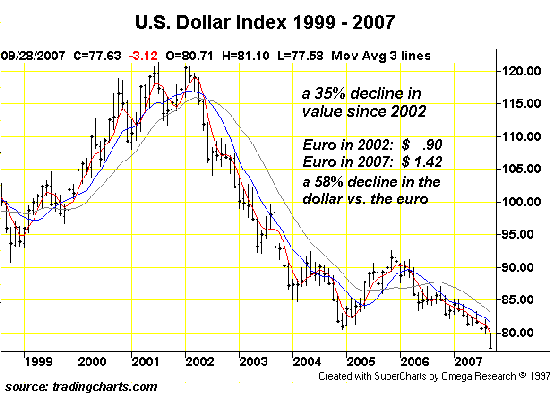

|
| weblog/wEssays archives | home | |||||||||||||||||||||||||
|
Is a Weak Dollar Really That Wonderful for the Nation? (October 25, 2007) The Financial Media loves to crow that the weak dollar is boosting U.S. exports, trimming the trade deficit and helping the juggernaut U.S. economy keep growing. Nice, but what about the pesky facts? Here is a typical happy-happy story by the reliable cheerleaders over at BusinessWeek: Exports: The Economy's Secret Weapon A narrowing trade gap will offset some of the housing-related weakness Amidst all the bullishly lavish praise for exports contributions to GDP growth, BW let slip a few lines of reality: Last year the gap, comprising the trade deficit and some other financial transactions, had risen to a record 6.2% of gross domestic product, from a mere 2.5% in 1998. Totaling $811.5 billion last year, the chasm between U.S. consumption and production required an equal amount of foreign capital to finance.The article goes on to claim that export growth will generate 175,000 new manufacturing jobs, but neglects to mention the U.S. workforce is about 133 million--all of whom will suffer from higher inflation, reduced purchasing power and higher borrowing costs as the dollar continues its decline. Here is a chart I've prepared showing the see-saw of the dollar's decline. While a relative handful gain, 300 million suffer disastrous consequences: 
The Commerce Department issues monthly reports on exports and imports; here are some highlights from the May report: In the month of March 2007 U.S. exports grew by 9.2 percent over March of last year to $126.2 billion, and imports increased 6.9 percent to $190.1 billion.Note the statistical legerdemain: exports rose at a higher rate, suggesting whoopie-do, we're solving the trade imbalance, but since exports are only 65% of imports (on an annualized basis--see below), the actual export gain of 9.8% is only slightly larger than the 4.3% rise in imports. Here is a chart of imports and exports since 2002, drawn from the Census Bureau's U.S. Trade in Goods and Services - Balance of Payments (BOP) Basis report:
Here's a chart of the dollar. Note the 35% decline from 2002: 
To be accurate, we need to adjust U.S. exports by this 35% decline in the dollar. Why? Let's say you sold 100 euros of U.S.-made goods in Europe in 2002. You exchange the 100 euros for dollars and get $90 for your exports. Fast-forward to 2007. Your 100 euros of exports are now exchanged for $142. Wow! Our exports rose by $52! Great! But oops--the gain wasn't from more good sold--it was all forex (foreign exchange). Granted, exports of actual goods and services have risen; and of course exporting companies hedge currencies to minimize the disruptions of currency fluctuations. All of this makes it difficult to measure these huge numbers accurately. But still, if we multiply the $974 billion in 2002 U.S. exports by the 35% loss in the dollar's purchasing power, we get $1.3 trillion--which suggests a majority of the export gains reflected in this chart are not in actual goods shipped but in dollars depreciated by our "low interest rates are good" Fed and Treasury. There's another fly in the ointment: inflation. A modest gain in exports helps a few select global corporations boost their dollar-denominated profits and a couple hundred thousand workers; but meanwhile, the inflation triggered by the weakening dollar drops the purchasing power of all 300 million Americans. Bottom line: the weakening dollar is good for a few and bad for everyone. The Federal Reserves is destroying the purchasing power of 300 million by cutting interest rates to support its grateful buddies in the stock market and investment banking industries. The pitch, of course, is that "low interest rates help us all," but once you factor in inflation from rising oil and imports, that's not quite the unalloyed blessing the Fed claims. Thank you, Sean H., ($50.00) for your very generous donation to this humble site. I am greatly honored by your support and readership. All contributors are listed below in acknowledgement of my gratitude. For more on this subject and a wide array of other topics, please visit my weblog. copyright © 2007 Charles Hugh Smith. All rights reserved in all media. I would be honored if you linked this wEssay to your site, or printed a copy for your own use. |
||||||||||||||||||||||||||
| weblog/wEssays | home |